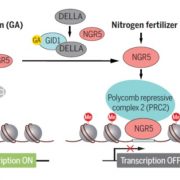
Enhanced sustainable green revolution yield via nitrogen-responsive chromatin modulation in rice ($) (Science)
The well-known success of the green-revolution was accomplished through the development of semi-dwarf grasses (rice and wheat), which led to decreased losses to lodging and higher yields; however, the benefits of these improved varieties depends on the application of nitrogen-rich fertilizer. As N-rich…
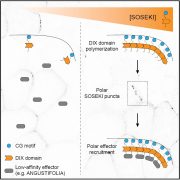
DIX domain polymerization drives assembly of plant cell polarity complexes (Cell)
In multicellular organisms like plants, asymmetric cell division can arise from cell polarity. The signals that establish cell polarity relative to the body axis are unknown in plants. In Arabidopsis, SOSEK1 was previously identified as having a polar distribution. SOSEK1 has a DIX domain similar to…
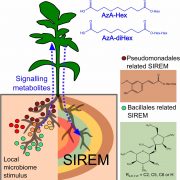
Rhizosphere microbiome mediates systemic root metabolite exudation ($) (PNAS)
Roots exude metabolites that affect the composition and activities of their microbiome. Korenblum et al. show that the microbiome in turn affects metabolite exudation, not only locally but also systemically (shown using a split-root system). They call this response SIREM: systemically induced root exudation…
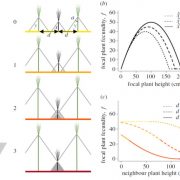
Farming plant cooperation in crops (Proc. R. Soc. B.)
If you want a great plant, select for a strong, vigorous, high-yielding individual; this is also the outcome of natural selection. But if you want a great field of plants, these traits may not be as suitable, because the plants will expend energy competing between themselves. When seeds from many plants…
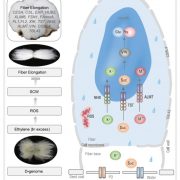
Review. Gossypium genomics: Trends, scope, and utilization for cotton improvement (Trends Plant Sci)
Cotton (Gossypium spp.) provides the world’s most important natural fiber, and I suspect with our growing realization of the problems with plastics there will be still more demand for it. Yang et al. review the current state of Gossypium genomics. As a crop that has been domesticated for millennia,…
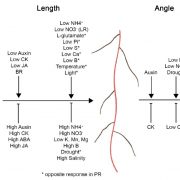
Review. Same, but different: growth responses of primary and lateral roots ($) (J. Exp. Bot.)
Lateral roots arising from programmed cell division from primary roots in both monocots and dicots share some similarities and dissimilarities in developmental signaling. In this review, Waidmann et al. discuss lateral root organogenesis and elongation with respect to hormone, nutrient, and abiotic conditions.…

Reciprocal cybrids reveal how organellar genomes affect plant phenotypes (Nature Plants)
A cybrid is a cytoplasmic hybrid; in other words, a cell or organism in which the cytosolic genomes (mitochondria and plastid) have a different origin than the nuclear genome; the nuclear genome is inherited solely from the paternal parent, and the cytosolic genomes from the maternal parent. Starting…
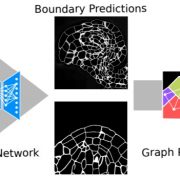
Accurate and versatile 3D segmentation of plant tissues at cellular resolution (bioRxiv)
Advances in microscopy allow biologists to document and understand phenotypic changes at the tissue level. Despite this advancement, analysis of microscopic images to characterize changes in phenotypes is still under development. In this paper, Wolny et al. have developed an image analysis tool PlantSeg…
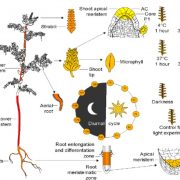
Expression atlas of Selaginella moellendorffii provides insights into the evolution of vasculature, secondary metabolism, and roots (Plant Cell)
Lycophytes, including the model species Selaginella moellendorffii, are extant (still alive today) seedless vascular plants that were particularly abundant around 400-300 million years ago (and major contributors to the formation of coal). To further understand the biology of some of these oldest extant…

